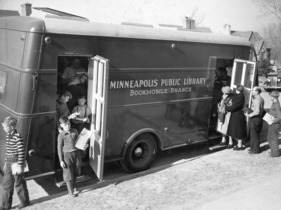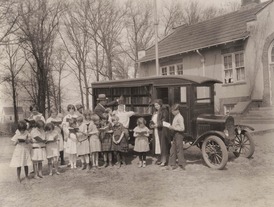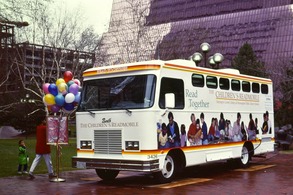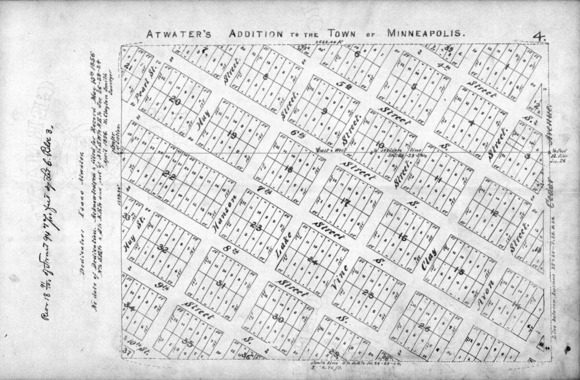|
November/December 2024
Check out what’s new and noteworthy this fall in Special Collections.

Saturday, November 16, 10a.m. - 12p.m., East Lake Library
Learn how to archive, organize, and preserve the records of your organization or group for the future. Led by the Hennepin County Library Special Collections archivist, this class is designed for staff and volunteers from any type of community group and anyone who has an interest in preserving local history. Leave class knowing how to store and preserve documents, photos, digital files, recordings, and more, and be prepared to organize your group's history. Register online
|
 |

The Minneapolis Public Library Bookmobile began in 1939 as a response to the growing need for library services in underserved areas. It was a mobile library service that allowed residents to borrow books and access library resources without having to visit a stationary library branch. Over time, the bookmobile became a beloved fixture in the community, providing educational and literary resources to diverse neighborhoods. Reaching its peak circulation in 1961, the service was discontinued in the 1980s due to budget constraints. It was reinstated in 1995 and continued to serve the Minneapolis community until 2005.
|

Even before the Hennepin County Library was officially established, the Minneapolis Public Library was already innovating library services for those living outside the city limits. Once the county library system was founded in 1922, the book wagon, an early form of a library on wheels, became an incredibly popular resource. Over time, the service evolved from the initial book wagon into a more sophisticated walk-in truck, eventually becoming what was known as the Bookmobile. The Bookmobile was notable for its high circulation rates, reflecting the strong demand and reliance on this mobile library service. As branch libraries were established throughout the county, the need for the Bookmobile decreased. With the decline in circulation and subsequent budget cuts, the decision was made to discontinue the Bookmobile service in 1995.
|

The Children’s Readmobile was a joint effort between Minneapolis Public Library and Hennepin County Library to bring early literacy resources and materials to childcare facilities in Hennepin County. Launched in 1991, the Readmobile carried 13,000 volumes of picture books, multicultural materials, easy nonfiction, magazines, audio and video tapes, and puppets, all available for children and childcare providers to check-out. In addition to providing library materials, the Readmobile partnered with the University of Minnesota’s Center for Early Education and Development to conduct research on the impact of the Readmobile’s services on childhood literacy. In 2009, the Readmobile was discontinued due to budget cuts in library funding.
|
Special Collections received the following new donations in the fall:
- Hennepin County Library Technical Services Scrapbook by Inese Jansen
-
Band Posters from Tim Carroll - Screen printed posters from various local bands and venues.
-
Book research materials from J. S. Futcher – Notes, drafts, and supporting documents for Futcher's book "They're Closing My Library - From Jordan to North Regional."
-
Prospect Park Association Records (Accrual 2024) – Board of director minutes, committee binders, and project files documenting the neighborhood in the 2010s.
-
NorthPoint Health and Wellness Center (2024 Accrual) – Newsletters, annual report, and photographs from 2023 added to our existing NorthPoint archive.
-
Alive and Kickin Records (Accrual 2024) – Advertising flyers, programs, and mailers for the most recent seasons added to our ongoing collection.
-
South Side Oral Histories – A series of oral history interviews documenting South Minneapolis residents impacted by 35W construction. Interviews conducted as part of University of Minnesota coursework in Spring 2024.
-
Minneapolis Audubon Society Records (Accrual 2024) – Board minutes, foundational documents, directories, brochures, subject files, scrapbook, and financial records of the Minneapolis Audubon Society from the 1920s to the present. These records will be added to our existing archive on the society.
-
Groveland Gallery Records (Accrual 2024) – Artist files including biographies, exhibition inventories, correspondence, exhibit advertisements and promotional materials, slides, and photographs.
-
Kent Jensen Pride Parade Photographs – Photoprints and negatives of the 2000 and 2004 Pride parades.
Our archives continue to grow thanks to contributions from members of our community. Thank you for helping us preserve local history! If you have material you think would be a good fit for our archive, contact us at specialcoll@hclib.org.

The 1880s were Minneapolis’ “Boom Town” years. For the only time in its history, the city’s population grew by over 100,000. Land annexations in 1881, 1883, 1885 and 1887 greatly expanded the size of the city. Property surveyors could hardly keep up. The “plat maps” they created were legal documents representing a property owner’s land divided into individual parcels which could be sold to individuals or businesses. In the massive building boom that accompanied the City’s population explosion of the 1880s, these maps were essential.
A civil engineer, Gustav Christian Brynildsen, created his first volume of such plats for use by “leading attorneys and abstract men.” He copied hundreds of these plat maps for additions in Minneapolis from the Hennepin County Recorder’s Office and bound them as folio volumes (Digital versions of many of these original plat maps from the 1880s are available in our Digital Collections.). The demand for his first volume was such that Brynildsen produced supplements in each of the next four years. The volumes have greatly deteriorated and are now falling apart. In an effort to preserve them and provide access to their contents, all of the volumes have been scanned.
We asked Special Collections volunteer Will Craig to take on the task of creating the descriptive metadata for each plat. Will and maps go way back: A student of the great geographer John Borchert, he wrote his dissertation on the subject of land parcels and used maps throughout his career as a geographer and pioneer in the development of GIS. But he says he’s primarily been interested in the project because “it’s useful!”
Additions are often superseded, and street names change, or disappear entirely. Determining exactly where an addition was can be challenging. Will uses a variety of resources to scout this out, including City atlases from the 1870s and 1880s, City neighborhood maps, and Hennepin County’s section maps.
“It all goes back to the land surveys,” Will observed, referring to the original surveys of the state’s lands in the 1840s and 1850s. Each plat records the township, range, and section numbers for the location of property being described. Additions may come and go, street names may change, or disappear, but the land survey data is forever, and often the only way to determine property location. “Hennepin County has been a leader”, Will remarked, in providing this kind of free property information to public.
Will’s work on the project is wrapping up: Brynildsen’s first volume and two of the supplements are now online, with the remaining two supplements soon to come. Asked if there were any surprises during the project, Will said the many name changes that took place (“1st Avenue North used to be Utah Street”) and the variety of addition names. Additions were often named after where they were located, or after individuals, anyone from big-time developers (e.g., Louis Menage) to small landowners looking to make a buck from their 10 acres. Enticing names were also commonplace, like “Sunny Lands” or “Forest Place.” On the other hand, one that caught Will’s eye was the “Cheap Side Addition”, which no longer exists. “The name must not have gone over very well,” he guessed.
 |

The International Stock Food Company, originally an animal feed business, was founded in Minneapolis in 1886 by Marion Savage. Savage hit on the slogan “3 Feeds for One Cent” for his key product and quickly became a success. He purchased the old Minneapolis Exposition Building in 1895 and expanded his business internationally, setting up partner companies in several countries.
Savage was also heavily into horse racing and made perhaps the best decision of his career in purchasing the pacing horse Dan Patch in 1902. Harness horse racing was extremely popular in those days and Dan Patch’s string of victories brought Savage both wealth and fame.
Savage bought land south of the Minnesota River and built a farm and stables both for Dan Patch and his many other racehorses. The farm became a tourist destination, bringing Savage more wealth. The town of Savage, named for him, grew up around the farm.
The posters in this collection date from the early 1900s and reflect the success of Savage’s feed business and the fame of Dan Patch. The stylized images, with stiff human figures, anthropomorphic animals, and often lurid colors were already somewhat antiquated, reflecting 19th century styles, rather than those of the new century. Nevertheless, the business continued to expand. Savage developed new lines of business, including the M. W. Savage Company, which offered what was virtually a “Sears catalog” of products with its “Send to Savage” catalogs. Many more of these can be viewed in the Special Collections department.
Dan Patch died in 1916 at the ripe old age of 20. His owner, who had already been ill, passed the next day, purportedly of a broken heart over the loss of his beloved horse.
Browse the stock food posters online
|
 |

James K. Hosmer Special Collections
Hennepin County Library
Minneapolis Central Library
300 Nicollet Mall
Minneapolis, MN 55401
Hours: Monday - Thursday, 9am - 4:30pm.
Appointments are not necessary, but you do need to call Special Collections or check-in at the 4th floor reference desk upon arrival for department access. You can speed up your visit by requesting materials be pulled in advance. Photocopier and scanners are available. Please bring a flash drive to store your scanned images.
Photo: Inside the climate-controlled Special Collections vault, where rare books, negatives, and AV material is stored.
|
|